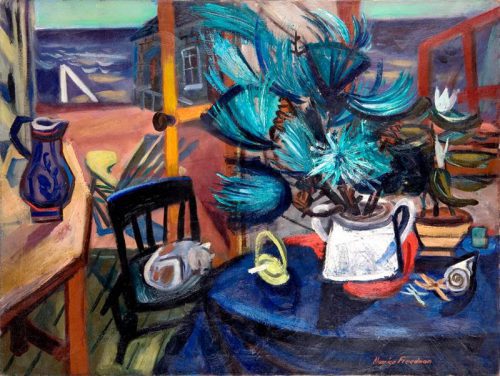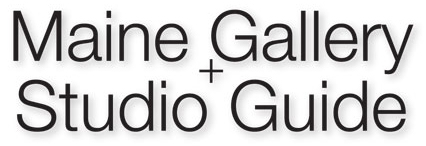
From August 8-31, Greenhut Galleries in Portland is proud and honored to present Rising Fog: Maurice Freedman in Maine, with an opening reception on August 8 5-7. This is the gallery’s fifth solo exhibition of the work of American Modernist painter Maurice Freedman. This survey spans 45 years of the artist’s distinguished and prolific career. Included are twenty-two seascapes and still lifes painted between 1932 and 1977 and inspired by the artist’s numerous excursions to Maine.
Freedman’s 1977 painting, Rising Fog, is a panoramic vista of the foggy New England coast. Far from the somber, ominous shroud ingrained in the popular imagination, the fog is captured as ephemera, a joyful expression, both atmospheric and energetic in a soft and cheerful palette. As such, it was chosen as the titular painting for this retrospective, which celebrates the vitality of the artist’s work as well as his love and abiding fascination for the New England landscape. That of Maine in particular.
As the art critic Stephen May observed in his December 2009 ARTnews review of Freedman’s work:
Like Winslow Homer, Freedman memorialized the endless battle between restless sea and obdurate rock in forceful depictions. In “Inlet Wave, Ogunquit” (1963), spectacular waves slam relentlessly against the rockbound shoreline.
The powerful painting referenced in May’s review is included in our exhibition.
Maurice Freedman was equally attuned to the magic and mystery of Maine’s inland scenery. His moonlit 1940 stunner, Thistles in the Night, perhaps the most glamorous treatment Mt. Katahdin has ever received, seduces the viewer to a spellbound silence. The painting’s preponderance of blues and purples sets the mood at deepest midnight. Kohl black lines define the shape of the mountain and the leaves of the thistle plants, intoxicating the eye with their angles and curves. The mid- and foreground palette is rich and sumptuous, it’s aquas, pinks and touches of white almost shimmer among maroons, reds, shades of peach, salmon and green. These lighter colors create the illusion of illumination under the moon and the stars, which “twinkle” in their loose treatment. The thistle flowers seem regal, like tassels on a gown, and all the painting’s lines and patterns aspire upward, toward the night sky and the strong silhouette of the mountain.
Scrub Pine Still Life (1947) is another gorgeous example of the artist’s skill in staging a scene.
As in many of Freedman’s still lifes and interiors, and as we see also in this exhibition’s Summer Still Life and Wellfleet Studio (1977), the doors are flung wide open. This invites a heavy whiff of salt air into the room and into the viewer’s imagination. It also creates a playful and pervading sense of mystery — underscoring, perhaps, the artist’s reverence for nature, his affinity for unbounded spaces, and his intuitive sense of the interconnectedness of all things.
This retrospective is organized around a central theme as a subset within the wider and more varied subject matter painted across the artist’s productive career. But the viewer gets a sense of how Freedman’s style developed, though not always linearly, over 45 years. While certain compositional elements change a bit over time, the vivid imagination and coursing vitality that are hallmarks of this masterful painter’s style remain constant. Through his flair for the dramatic and the complete command of medium shown in his assertive brushstrokes and his bold use of color and patterning, Freedman’s sui generis synthesis of abstraction and figuration are apparent throughout. As are this artist’s joie de vivre, his attunement to scene, his love of beauty, and his lifelong love affair with the act of painting.
Maurice Freedman was born in Dorchester, a suburb of Boston, and educated at the School of Museum of Fine Arts, Boston, Massachusetts College of Art, and the Art Students League of New York. Perhaps more important was his study in 1920’s France with Andre Lhote and Ferdinand Leger. His work has been exhibited at the Metropolitan Museum of Art, Carnegie Institute, Whitney Museum of American Art, Pennsylvania Academy of Fine Art, Art institute of Chicago, Corcoran Gallery, Brooklyn Museum, Walker Art Center, and Toledo Museum. His work is in the collections of the National Museum of American Art, Smithsonian Institution, Pennsylvania Academy of Fine Arts, Denver Art Museum, Butler Institute of American Art, City Art Museum of St. Louis, Milwaukee Art Institute, Los Angeles Art Museum, and the Minneapolis Institute of Art.

Our August side gallery exhibition offers an additional slice of Americana, via Alison Rector’s brand new body of work, Train Journey. In these paintings, the artist has created a beautiful document of the sights, and as always in Rector’s work, the light observed during a trip recently taken via Amtrak. We’ve shared Alison’s first person account of her exciting project and her journey below:
In 2018, work responsibilities required me to travel from my home in mid-coast Maine to Rochester New York.Air travel options were inconvenient and expensive. I didn’t want to drive. Instead, I decided to make mytransportation choice into a visual adventure on the train.
I knew that Amtrak granted writers access to train travel as inspiration for writing, and that residency program had long been on my radar. (This program has now been replaced by Amtrak’s Social Media Residency.)What if I took the train from Maine to Rochester? Could I create my own visual arts residency on the train?
Trains have facilitated transitions for me in the past, reliably pairing transportation with time for deep thought. When I moved as a young adult from the East Coast to California, I arrived in Oakland by rail after a three-day coach journey from Chicago.The rocking motion and the meditative rush outside the window mesmerized me. Since then, I’ve sought train travel in many parts of the world: with my husband traversing the width of China from Shanghai to Xinjiang, dissecting southern India, and between many European cities as well. Countless trips up and down Amtrak’s Eastern Corridor have transported me since childhood.
“There is absolutely no reason to take the train across the United States”, writer Caity Weaver “but I did it anyway.” Her March 2019 story about cross-country train travel, titled “We’re all in This Together” appeared as I was deep in studio work for this show. Trains provide “a chance to look behind the American scrim” writesWeaver, “to learn where the nation makes and stores the hidden parts that run it, to find new places you wish you had been born, to spy on backyards and high school football fields whose possible existence had never occurred to you.”
Train fare from Boston South Station to Rochester’s Union Station cost $46. A bargain. I expected the Lake Shore Limited route would be visually rich. And, having just finished work on a long-term painting project inspired by 19th century industrialist Andrew Carnegie’s legacy of public library building, train travel through New England’s industrial past seemed like a logical next step. The journey out of Boston across the width of Massachusetts into New York winds over rivers, through forests and farmland, and pierces small city centers. We passed empty warehouses, tangled backyards, bridge underpasses, and old manufacturing sites, all interspersed with recent changes to the landscape, such as solar farms. The train journey fueled me as I’d hoped; the15 paintings in this show are inspired by that trip on the Lake Shore Limited and beyond.
In addition and as a complement to Alison’s visual work, musicians Bennett Konesni and Edith Gawler will present a program of train songs in the gallery on Wednesday evening, August 14th from 6 to 8 p.m. Alison and all of us at Greenhut hope to see you at this fun event!
Alison Rector Rector earned an undergraduate degree from Brown University in Providence RI, including courses at the Rhode Island School of Design. Her work was included in the CMCA’s 2018 Biennial, and, in 2017, her Carnegie Library paintings were featured in a solo exhibition at the Ogunquit Museum of American Art, entitled The Value of Thought. Her work is also included private collections across the country. Train Journeys is Rector’s fourth solo exhibition at Greenhut.
Categories: Artists Reception, gallery, Portland, shows
Tags:

